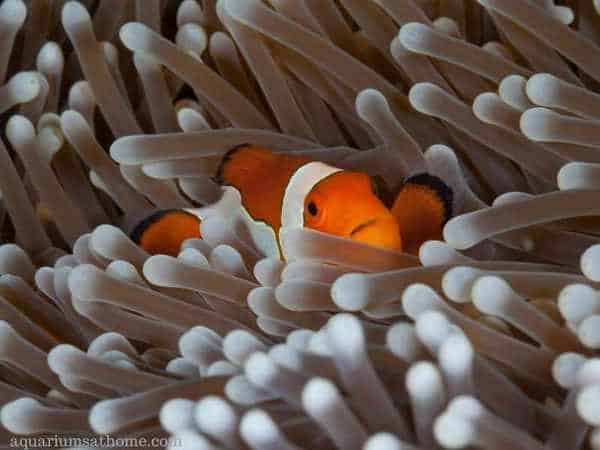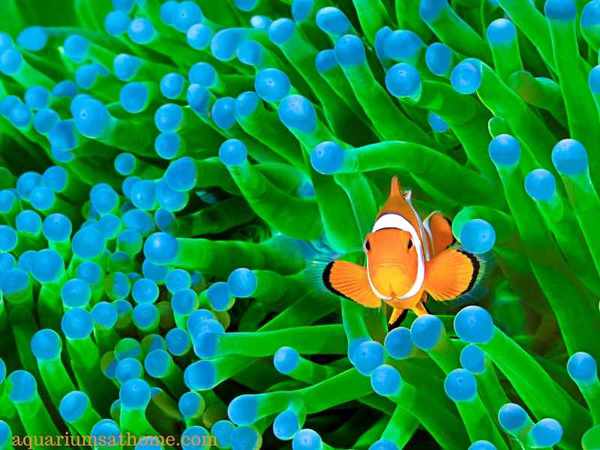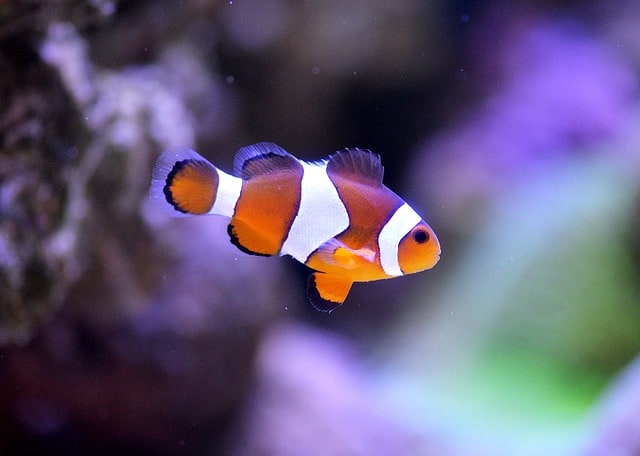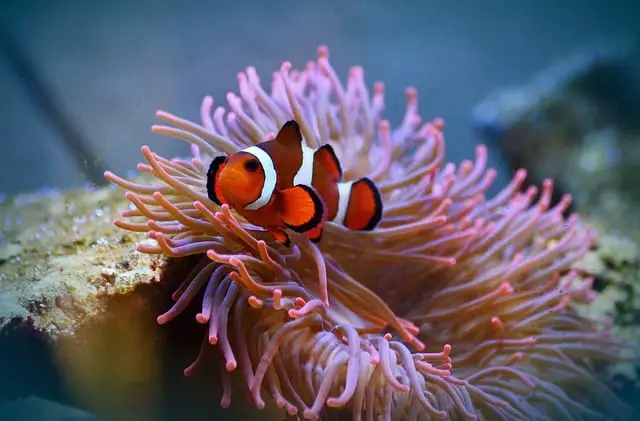Clownfish or clown anemonefish got their name from their appearance and the symbiotic relationship they form with sea anemones. Amphiprion ocellaris (their scientific name) are a common choice among aquarium hobbyists and make a great addition to almost any saltwater reef tank. But what makes these cute little fish so popular?
The popularity of clownfish rose after the debut of the Disney Pixar animated film ‘Finding Nemo’ and again following the release of the sequel ‘Finding Dory’.
Clownfish are popular because they stay relatively small, are active and fun to watch, are beautifully colored, are easy to feed and care for, and have a relatively peaceful temperament.
Now that you know why clownfish are so sought-after nowadays, let’s explore this topic further. We’ll discover in more detail the main reasons for their heightened popularity as well as learn whether it’s considered cruel to keep them in captivity. We’ll also learn if they like humans and whether they can recognize their owners.
So, if you’re ready to learn more about clownfish and why they’re so well-liked by fish lovers of all ages, and then let’s begin!
Seven Reasons Clownfish are So Popular?
On the big screen back in 2003, a beloved little fish named Nemo captured the hearts of moviegoers. Since then, clownfish have been considered ‘special’ by both children and adults alike. They’ve also become highly popular with saltwater aquarists for the following 7 reasons:
1.Small and Easy to Care for
Clownfish stay relatively small (reaching full-grown lengths of about 4 inches) and therefore are perfect for a nano reef tank (10-gallons). They’re also hardy, non-picky eaters which makes them quite easy to care for overall and the perfect choice for beginner aquarium hobbyists.
The only thing clownfish really need is a clean environment. A tank free of debris and toxins is necessary to ensure they live long, healthy lives. Weekly partial water changes of at least 15% are recommended, especially when clownfish are kept in mated pairs in a smaller tank.
2.Like to Stay Close to Home
Clownfish like to stay close to their host anemone – if you have one. If you don’t, that’s not a problem as the clownfish will still pick a spot in the tank to call home and won’t venture too far away from that spot for very long.
Clownfish by nature are not long-distance swimmers. They swim mostly vertically rather than horizontally. This is yet another reason they’re so popular since you don’t need a long or large fish tank to accommodate this species.

3.Beautifully Colored and Fun to Watch
Clownfish, though typically bright orange with 3 white stripes outlined in black, also come in shades of pink, red, yellow, brown, and black with multi-hued stripes. For aquarists desiring a vivid and diversely colored tank, clownfish are the ideal option since they’re highly active and a joy to observe.
Feeding clownfish color-enhancing food is a great way to keep them vibrant-looking. Spirulina is a great choice. Rich in protein, this blue-green plant is a big part of the clownfish diet in the wild! Marine flakes are an easy, inexpensive option and are available online (Amazon) or at your local pet shop.
4.Relatively Peaceful Towards Tankmates
Clownfish are a mainly peaceful species and can cohabitate with a variety of like-sized marine fish such as pygmy angels, chromis damsels, and bangaii cardinalfish. That said, they can become aggressive when overcrowded and have been known to harass smaller, weaker fish.
Clownfish in captivity do best when kept in mated pairs and in a large enough tank with plenty of room to swim freely and claim their own territory. A sea anemone is also necessary since this species thrives from the symbiotic relationship formed.
5.Can Spontaneously Change Gender
One unique feature of the clownfish is its hermaphroditic ability to change sex! All clownfish are born male. When it comes time to procreate, the largest male in the group will spontaneously switch gender and become the dominant female.
For saltwater aquarium hobbyists, the ability to change sex can be quite appealing, especially if they plan to breed (and perhaps sell) clownfish. This makes it easy for them to pair up and reproduce with little effort on the aquarist’s part.
6.Considered to be Reef Safe
Clownfish (with perhaps the exception of the maroon) are considered reef safe, meaning they can be kept in a tank with corals and won’t pick at or damage live rock. This is great news for marine aquarists that specialize in reef tanks.
Be careful, however, for reef tanks with invertebrates as clownfish are omnivorous and like to eat tiny crustaceans such as hermit crabs and opossum shrimps. To prevent them from feasting on their fellow tankmates, keep them well-fed and with shellfish that are at least 2 to 3 in length.
7.Readily Available and Reasonably Priced
Clownfish, especially ocellaris or false percula are captive bred at fish farms all over the world. This makes them easy to find in almost any local fish store that sells marine fish. Since they’re typically not wild-caught, it also means the price for clownfish is more affordable.
Is it Cruel to Keep Clownfish?
If done improperly or without due care, keeping a clownfish (or any fish, for that matter) can be cruel. Like any pet, you must treat your clownfish humanely and provide it with a clean and safe environment in which to live. Offering it high quality food and keeping it with peaceful and compatible tankmates – especially an anemone – is of the utmost importance.
Do Clownfish Recognize their Owners?
Clownfish are among the few species of aquarium fish that ‘like humans’ and can recognize their owners – well, the person that feeds them anyway. Like angelfish and betta fish, clownfish will come to the surface when they see you in anticipation of being fed. You should always avoid the temptation to touch your pet clownfish as this can damage their slime coating, making them more susceptible to anemone stings.
The relationship you create with your clownfish is another reason they are so popular.

How Long do Clownfish Live in Captivity?
The average lifespan of a clownfish in captivity is anywhere between 3 to 10 years. However, with proper care and in an aquatic environment conducive to their natural habitat, this species has been known to live much longer – up to 20 years or more! The key to clownfish longevity is an exceptionally clean tank with near-perfect water conditions.
It’s been said that clownfish tend to live longer when hosted by an anemone. In fact, their very survival in the wild hinges upon this symbiotic relationship. Clownfish bond best with carpet anemones so you should consider adding one to your tank if you haven’t done so already. As well, clownfish will often endure beyond the average lifespan when kept together in mated pairs.
How to Increase Clownfish Longevity in Captivity?
To increase the lifespan of your pet clownfish, be sure to keep it in a clean tank with stable water parameters. A heated aquarium with a temperature between 76 to 82 degrees is recommended. As well, the pH of the water should be anywhere from 7.8 to 8.4 with a specific gravity of 1.021 and 1.026. If the water conditions are ‘off’, clownfish will become stressed and/or sick.
Clownfish survival is dependent upon food so offering it a varied, high-quality diet of both plant- and meat-based foods is a must. Making sure the tank isn’t overcrowded is also important since this species needs room to swim about freely and an area/territory to claim as their own. Keeping captive clownfish in mated pairs is also thought to improve longevity.
Final Thoughts
To conclude, the popularity of clownfish rose after the debut of the Disney Pixar animated film ‘Finding Nemo’ and again following the release of the sequel ‘Finding Dory’. They’ve remained popular because they stay relatively small, are active and fun to watch, are beautifully colored, are easy to feed and care for, and have a relatively peaceful temperament.
I hope you’ve found this article to be both interesting and informative. Thanks for reading and good luck with your aquarist hobby.
Recommended Posts
Can You Have 3 Clownfish in a Tank?
Why Do Clownfish and Sea Anemones Pair Up?
Clown Fish Tank Set Up for Beginners
Clarkii Clownfish Care Guide and Tank Setup (Behavior, Breeding, Tank Mates, etc.)
How Do You Tell if Clownfish are Fighting?






